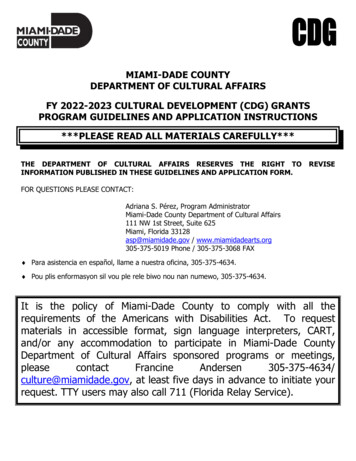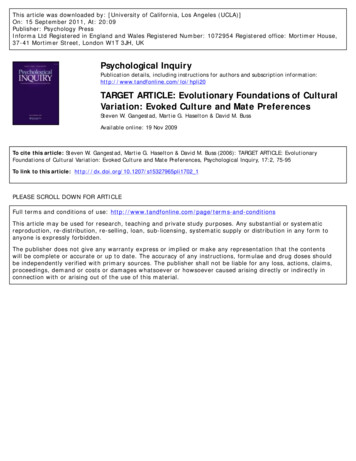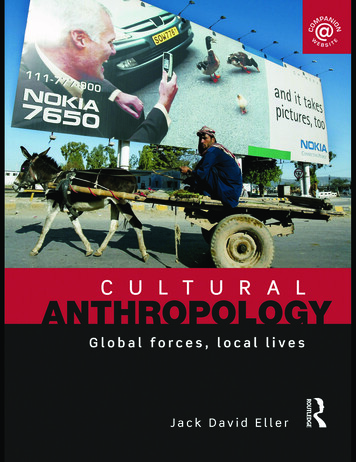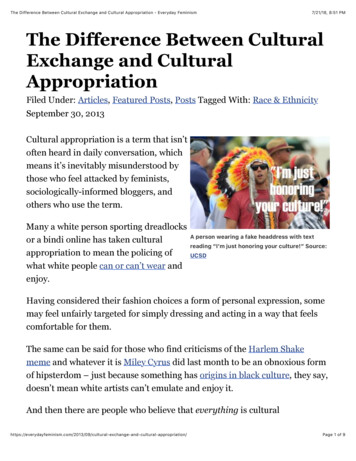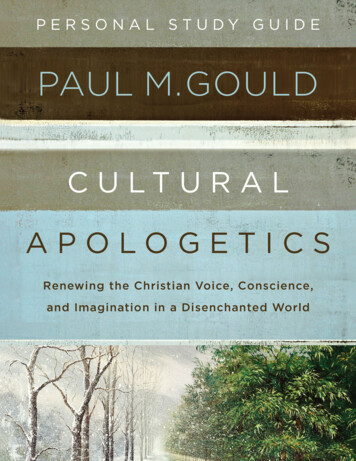
Transcription
Gkougkoulitsas, TheocharisCultural policy and management. The archaeological museum of theAcropolisJournal of Contemporary Education, Theory & Research 1 (2017) 1, S. 18-22Empfohlene Zitierung/ Suggested Citation:Gkougkoulitsas, Theocharis: Cultural policy and management. The archaeological museum of theAcropolis - In: Journal of Contemporary Education, Theory & Research 1 (2017) 1, S. 18-22 - ungenTerms of useDieses Dokument steht unter folgender Creative /by-nc-nd/4.0/deed.deSiedürfen das Werk bzw. den Inhalt unter folgenden Bedingungenvervielfältigen, verbreiten und öffentlich zugänglich machen: Siemüssen den Namen des Autors/Rechteinhabers in der von ihmfestgelegten Weise nennen. Dieses Werk bzw. dieser Inhalt darfnicht für kommerzielle Zwecke verwendet werden und es darfnicht bearbeitet, abgewandelt oder in anderer Weise verändertwerden.Mit der Verwendung dieses Dokuments erkennen Sie dieNutzungsbedingungen by-nc-nd/4.0/deed.en - Youmay copy, distribute and transmit, adapt or exhibit the work in thepublic as long as you attribute the work in the manner specified bythe author or licensor. You are not allowed to make commercial useof the work or its contents. You are not allowed to alter, transform, orchange this work in any other way.By using this particular document, you accept the above-statedconditions of use.Kontakt / Contact:peDOCSDIPF Leibniz-Institut für Bildungsforschung und BildungsinformationInformationszentrum (IZ) BildungE-Mail: pedocs@dipf.deInternet: www.pedocs.de
Journal of Contemporary Education Theory & Research, Vol. 1, No. 1, pp. 18-22, 201718Cultural policy and management:The archaeological museum of theAcropolisTheocharis GkougkoulitsasHellenic Open UniversityAbstract: The Archaeological Museum of the Acropolis. Strategy is always an importanttool for the development of cultural organizations that want to realize their mission andvision. Implementing a strategic management plan is essential for any organization. "Anyorganization that adopts the concept of strategic design should select elements from variousmanagement models that will then adapt to the specific operating conditions and the placewhere it operates." There are some basic common steps in all models, since when one triesto develop and design a strategy for managing each organization, one must answer thefollowing fundamental questions: - What is the point we want to go? - initiative purposes, What is our point now? -reviewing the current situation, -What do we need to do to be wherewe want to go? -Select a strategy, -What are we going to do? -control. The development ofthe strategy must be focused on the requirements and needs of the target audience andcompetition must always be calculated. Mission and objectives can be reviewed whenevernecessary In this paper the concept of strategy is first written out and the planning processfor the formation of strategic cultural units is analyzed. The case study examines theAcropolis Museum in Athens, the inauguration of which took place on July 21, 2009. TheAcropolis Museum is a Legal Entity of Public Law, belonging to the Ministry of Culture, butit is autonomous in several areas. It is run by a Board of Directors, chaired by Professor ofArcheology Dimitris Pantermalis. The new Museum of the Acropolis offers all the servicesprovided by the modern museums of the 21st century. Describe the strategic plan of theorganization at work, and on the basis of a SWOT analysis, its degree of viability is beingexamined for this period of economic crisis. It also analyzes the degree of efficiency of thestrategy for future development of the museum and evaluates the strategy on the basis ofqualitative and quantitative criteria.Keywords: Strategy, SWOT Analysis, Organization, Acropolis MuseumJEL Classification: I28Biographical note: Theocharis Gkougkoulitsas is a journalist, Msc holder from the TIONIn the present study, the concept of strategy and the planningprocess for the formation of strategic cultural units areanalyzed. The Acropolis Museum in Athens is thenconsidered as a case study where you describe the strategicplan of the organization and through the SWOT analysis it isconsidered its degree of viability during this period. Finally,the degree of viability during this period. Finally, the degreeof efficiency of the strategy for future development of themuseum is analyzed and the strategy is evaluated on the basisof qualitative and quantitative criteria.2 EXAMINE THE CONCEPT OF STRATEGY ANDANALYZE THE PROCESS OF PLANNING THESTRATEGY OF A CULTURAL UNITThe strategy as a word comes from the word general, whowas the commander of the army in ancient Greece, and thenCopyright 200 2017 Authors. Published by the Alexander TechnologicalInstitute of ThessalonikiISSN: 2654-0274. UDC: 658.8 338.48 339.1 hed online: 14 October 2017Some rights reserved.Except otherwise noted, this work is licensed /4.0
CULTURAL POLICY AND MANAGEMENT. THE ARCHAEOLOGICAL MUSEUM OF THE ACROPOLISused as an explanation of the "art of the general" (Hambouri& Ioannidou, 2003: 31). In Modern Greek, the definition ofstrategy by Professor Babiniotis implies that "an organizationis involved in the planning of its goal and its strategy"(Hampouris & Ioannidou, 2003: 31). While the concept ofstrategy has been used as a military term for centuries,cultural things have been used in recent years mainly byKotler and Middleton (Hampouris & Ioannidou, 2003: 31).Papadakis (1999: 8) says strategy is the common point ofactivity that the organization and its products / markets definewhat the nature of the business will be, previously and in thefuture. For the Boston Consulting Group strategy is aresource-sharing and resource-use plan of the organizationthat faces competition and stabilizes advantageously theorganization through its environment (Bourantas &Papalexandri, 1998: 126). There are, according toWhittington (1993), four schools of strategic theory:classical, evolutionary, procedural and systemic (Hampouris& Ioannidou, 2003: 34). The oldest and wider is the classicalschool that is rational and designed exante in every detailexclusively by the organization's management for the solepurpose of profit (Hampouris & Ioannidou, 2003: 34). Withthree words, he analyzed, designed and ordered. For theevolutionary faculty, the external environment of theorganization, which exerts pressure on the organization'schoices and not on its managers, has a primary role(Hampouris & Ioannidou, 2003: 35). In a nutshell, keep costslow and choices high. For the procedural approach, thestrategy is shaped by a combination of interactions within theorganization it assimilates (Hampouris & Ioannidou, 2003:35). That is, stay on the ground and go with the current. Thesystem follows logic considering the cultural context andlocal social forces for strategic planning. In short, play withlocal rules. In addition to the four strategic thinking schoolsmentioned above in recent years, a new approach hasemerged, based on the resources of the organizations theyhave in place to achieve their strategic goals (Hampouris &Ioannidou, 2003: 36). Strategy is always an important tool forthe development of cultural organizations that want to realizetheir mission and vision (Christou, 2006; Zunis, 2015). Theimplementation of a strategic management plan is essentialfor any organization (Hampouris & Ioannidou, 2003: 41)."Any organization that adopts the concept of strategic designshould select elements from various management modelswhich will then adapt to the specific operating conditions andthe area in which it operates" (Hampouris & Ioannidou, 2003:41). There are some basic common steps in all models whenone tries to develop and design a strategy for managing eachorganization to answer the following fundamental questions(Hampouris & Ioannidou, 2003: 41-42): - What is the pointwe want to go? -initiative purposes, -What is our point now?-revaluation of the current situation, -What do we need to doto be where we want to go-selecting a strategy, -Why are wegoing? -control, The development of the strategy must befocused on the requirements and needs of the target audienceand competition must always be calculated. Mission andobjectives can be revised whenever necessary (Wheelen T.,Hunger J., 2004).3SWOT ANALYSIS19The process of evaluating the present state of an organizationis compiled in the bibliography titled "SWOT analysis", anabbreviation of the initial letters, English words, strengths,weaknesses, opportunities and threats, respectively translatedinto advantages, weaknesses, opportunities and dangers(Hambouri & Ioannidou , 2003: 50). SWOT analysis is asimple and useful tool since it reflects a kind of strategicbalance that shows the strategic position of the organization(Hampouris & Ioannidou, 2003: 52).4 CRITERIA FOR SELECTION - EVALUATION OF THESTRATEGYA very prime point is also the control of the efficiency andeffectiveness of the chosen strategy. It is a continuousdevelopment, which, with reliable and practical criteria,explores the results, in order for the organization to be viableand improving, the satisfaction of the large public and itsproductive resources to evolve (Hampouri-Ioannidou, 2003:59). Control can still help with modifications to theimplementation of its strategy for profit.5 CASE STUDY: THE NEW ARCHAEOLOGICALMUSEUM OF THE ACROPOLISThe monuments of the acropolis have borne all the damagefrom ancient times to the Middle Ages. In the 17th centuryforeign travelers reported it and their wear began a few yearslater when the Ottomans for a fortification dismantled thetemple of Nike (Aspridis-Kordias-Kymeris-Kyriakos, 2014).In 1687 a Venetian bomb destroyed much of the monumentswhile the final hit came in the 18th century when the EnglishLord Elgin took sculptures from the Parthenon. The Greekstate decided in 1863 to build a museum and was founded in1865. This museum, with as many extensions as it did later,could not cope with the presentation of the exhibits but alsowith the needs of the visitors. In 1976, the prime minister,Mr. Konstantinos Karamanlis, delimited the space for theconstruction of a new museum, while the contribution of theMinister of Culture of the period 1981-1989 to MelinaMerkouri was enormous. In 2000, the last internationalcompetition was awarded to Bernard Tschumi and MichalisFotiadis (Aspridis-Strohlias-Kymeris-Kyriakos, 2014). Theproject "Creation of a New Acropolis Museum" was cofinanced by the Greek State and the Ministry of Culture andby the European Union and the European RegionalDevelopment Fund.The inauguration of the new Acropolis Museum took placeon 21 July 2009. Its total space is 25,000 m². and theexhibition area is 14,000 square meters, ten times larger thanthe old museum. The Acropolis Museum is a Legal Entity ofPublic Law, which is the Ministry of Culture, but it isautonomous in many areas. It is run by a Board of Directors,chaired by Professor of Archeology Dimitris Pantermalis(VIMA). The new Acropolis Museum offers all the servicesprovided by modern 21st century museums.
20Figure 1The new Acropolis Museum6 THE STRATEGIC PLAN OF THE ACROPOLISMUSEUM FOR THE PERIOD 2014-2020.The eighth year of operation of the Acropolis Museum (2017)had the same stable qualities as in previous years, as well asthe addition of new digital applications to the exhibitionvenues and the establishment of pioneering programs ofperiodicals (Dimitrios Pantermalis). There has been a greatand successful response by the Museum's staff to its visitors,which averaged 4,000 visitors per day, facilitating entry,movement and stay in the Museum's rooms of such massivetraffic (Pantermalis). The Honorable Distinction of theMuseum in 2017 by the users of the TripAdvisor guidebook,shows the bold extrovert policy of the Acropolis Museum(Pantermalis). There was a telephone interview of Mrs.Danais Zaousis from the Communication & PromotionDepartment to record the strategy. The Acropolis Museum,through its Strategic Plan for the period 2014-2020, isreviewing its mission as a museum by setting goals for thenext period as part of its bid for the whole country, and withmy goals being aligned with the practices other similar artmuseums as well as setting strategic goals that can standfinancially. The strategic plan of the Museum for the period2017-2018 is in line with the framework of the six-yearprogram (NSRF 2014-2020) in order to be in harmony withthe state-community co-financing program (tornosnews.gr).Its structure has the following form.The Structure of the Strategic PlanWe will present the structure of the strategic plan of theAcropolis Museum Cultural Organization that was donethrough its own targeting methodology based on its ownneeds and choices for the 2014-2020 period and is as follows:1. The mission and the fundamental principles of the Museum(missionandvalues). 2. Text of the introduction by thedirector of the museum, Mr. Pantermalis (director'sforeword). 3. The plan in brief, a summary of the key pointsof the Strategic Plan. 4. Set-scene presentation with the subsections: 4.1) Analysis of the strategic environment. 4.2)Gkougkoulitsas T.Analysis of museum performance (efficiency / visibilityindicators - operating cost per visitor). 5. Presentation ofstrategic objectives of the museum: - For the 2014-2020period, the museum had five (5) key strategic goals. - Eachgoal is defined by specific priorities, ie specific axes for theimplementation of the target, each of which has the name ofthe executives responsible for implementation. -The targetingmethod we mentioned is summarized in the followingrelation (Zounis, 2015):Goal-Priorities-StrategiesThe main strategic goals of the museum according to theStrategic PlanAccording to the strategic plan, the main strategic goals ofthe 2014-2020 Museum are the following: 1. Thesignificance-priority of the permanent collection for theMuseum. Symposium with the new Ministry of the Interior'sstrategy to claim the return of the Parthenon sculptures at theBritish Museum (Zaoussi, 2018). 2. Strengthen the Museum'seducational program and periodic exhibitions with the aim ofquantitatively and qualitatively increasing traffic. 3.Maintaining high quality standards at all levels of itsoperation and service delivery. Strengthening managementsystems and organizational capacity. 4. Financial stabilityand then economic empowerment of the museum. 5. Creatinga multi-dimensional website for the Acropolis Museum thatwill include (tornosnews.gr): - Information about theMuseum and the organization of a visit to it, - Presentationthrough the Collector Management System of the collectionof the 10,000 objects of the Museum. - "Virtual" OnlineMuseum where the visitor will schedule his visit according tohis interests, creating a "personal collection" of favoriteexhibits through applications (Zaoussi, 2018). - Children'sClub Website, where children will be able to tour theMuseum and learn about ancient culture by learning to play(Zaoussi, 2018). We note that the main strategic objectives ofthe museum for the period 2014-2020 correspond to a widerange of issues that are: a) cultural-educational-social role ofthe museum along with marketing issues (increase of traffic),b) improvement of the administrative / capacity, c) elevationin financial income, and d) functional-ergonomic issues.7 SWOT ANALYSIS, ADVANTAGES ANDDISADVANTAGES OF THE ACROPOLIS MUSEUMThe main goal of the Acropolis museum is to preserve asmuch as possible the treasures that the museum has in itspossession (Zaoussi, 2018). The museum was designed withtwo objectives. Being able to offer the best possibleconditions to present the projects he has in his possession andto be friendly to his guests (Sgoura, Ch., 2016). Its strengthsand weaknesses are those that concern its interior and theopportunities and threats are the wider socio-economicpolitical environment that can affect it. In Opportunities wecan mention globalization and almost free, which increasesthe impact of the Museum. The rise of the averageeducational level still increases access to art. Also, thedevelopment of technology is another opportunity as well asthe new ways of networking the youth (eg blogs, facebook,instragam, twitter, etc.). In Threats we can say thatglobalization eliminates borders but increases competition at
CULTURAL POLICY AND MANAGEMENT. THE ARCHAEOLOGICAL MUSEUM OF THE ACROPOLISinternational level. The financial crisis fails the resources ofthe Museum as there is a decline in the purchasing power ofconsumers (Pappas, 2017). At the strong points we canmention the name of the Museum and the prestige it inspires.Also the Museum's vision. Still, we have to mention that thevisitor can see permanent, seasonal or periodical exhibitionssupported by valuable services such as guided tours orpersonal guided tours (Aspridis-Kordias-Kymeris-Kyriakos,2014). There is interactive visitor involvement using touchscreen displays, with visual 3D but also with virtual reality,with projections or even with documentaries. The visitoroffers a sense of exhilarating exposition which iscomplemented by the provision of hospitality services suchas restaurants, cafes and childcare facilities (Zaoussi, 2018).The museum is designed to support the access of all itsvisitors to culture, with special ramps and special lifts,Braille, and other audiovisual media (Asprid-StrohliaKimeris-Kyriakou, 2014). It is environmentally friendly andconnected to the most modern technological applications,attracting so many new people. The Acropolis Museum isNo. 1 among the 327 activities in Athens and 94% of itsratings in the tripadvisor travel guide are excellent (76%) andvery good (16%) (tripadvisor). The strategic position of themuseum is completed by its topographical position adjacentto the Acropolis monument and the theater of HerodesAtticus, three sights that are co-operating with each other(Aspridis-Strolia-Kimeris-Kyriakou, 2014). The secondmuseum in Athens, the Archaeological Museum, has onethird of the Tripadvisor's visit to the Acropolis Museum. Thedesign of his exhibits must be oriented towards fulfilling hisgoals, namely attracting new visitors, reducing his operatingexpenses, increasing his income and increasing thesatisfaction of his clients. In the Acropolis Museum thedesign was the one who helped to fulfill his goals. Throughmodern management systems it can reduce its operatingcosts. It is environmentally friendly, has been built withrecyclable materials of high energy efficiency and is capableof operating under any weather conditions (AspridisStrohlias-Kimeris-Kyriakos, 2014). It is safe with theintroduction of modern security systems and can be used bycompanies as well as by ordinary visitors. The AcropolisMuseum still with innovative exhibitions and collaborationssuch as those with the Shanghai Museum and the New YorkMuseum has, during this time of crisis , to make sure thatchoice in quality is not dependent on the crisis (Zausis, 2018).Weaknesses should include the non-autonomousadministration, the limited number of employees and the lackof sufficient financial resources. The era of crisis requirespartnerships / partnerships that can be saved. Thecollaboration and sponsorships of major Greek companiessuch as ETEM, who was the great sponsor of the exhibition"Tourism Landscapes by Reconstructing Greece", is anexample. The Museum's plan envisages tightening publicrelations with local and national institutions, educationalinstitutions or other organizations with a similar strategictargeting (Zaoussi, 2018). The museum's property is itspeople. The training, training and development of thecapabilities of the existing staff are essential for thedevelopment of the museum (Aspridis-Strohlias-KimerisKyriakos, 2014).21Performance review of the strategy-evaluationIn such a modern museum that is the head of the country'smuseums, it is difficult to find any disadvantage in itsstrategic course. The Acropolis Museum faithfully followsthe theory of implementing a strategic plan, recording thegoals and ways of applying them. Magnificent but alsosystematic, it is worthwhile to fill its inspiration and increaseits traffic to more than 1.5 million visitors a year now. Thepolicy of continual control of its capabilities through itsannual summary with reference to profitability ratios, as wellas a detailed understanding of its financial situation, is apowerful asset for achieving its goals. The detaileddescription of each individual sign, accompanied by excellentgraphic editing of the brief account, makes it attractive.However, looking at the elements of periodic annual reports,the signs of the economic crisis are visible. While the fiveyears of its operation had a 10-12% increase in traffic eachyear (Kontraŭ-Rassia, 2014), in recent years the number ofannual visitors has stuck to about one and a half millionvisitors. Here, it should be noted that while the museum ispublic and not private, it does not receive a state subsidy andoperates exclusively from its own revenues and a budget of6.5-7 million euros coming from tickets, souvenir sales andcoffee- restaurant without any profits (Kontraŭ-Rassia,2014). The Museum's management by the Organization forthe Construction of a New Acropolis Museum must go to thenew Museum. Managerial and staff positions must beproclaimed to operate under the new regime (Kontraŭ-Rassia,2014). His expansive intention to create a digital museum thatis being prepared will give impetus and bring additionaleconomic benefits. At the end of 2017, the Region of Atticafinally secured resources for the creation of the DigitalAcropolis Museum, with a total budget of 1.74 million euros(tornosnews.gr). Here we have to add that this is arequirement of the museum since the beginning of itsoperation.8CONCLUSIONSThe strategy is an important development tool through whichcultural organizations can realize their goals and visions. Astrategic plan depicts the entire strategy of the culturalorganization that is the mirror of the organization to theoutside. The strategy and its applications (strategic planningand strategic plan) are not vague and abstract concepts, butsomething specific that is shaped according to the actualneeds and functions of a cultural organization. Theorganization that has a clear mission, owns what its potentialand weaknesses, opportunities and risks, with the right choiceof strategy and performance control, can ensure itssustainability. Investigating the case of the AcropolisMuseum we come to a conclusion with a positive sign, sinceits strategic planning at all stages of its development worksin a coordinating way in order to benefit its mission andgoals. By reporting and evaluating the advantages anddrawbacks of this design through the study of his strategicplan, financial figures and performance indicators, we cometo the main result that we conclude, having regard to thecurrent economic situation, the strategy of an organizationshould not be above the possibilities that can be funded, but
Airline Ratings22 the mission and goals of the organization with the currenteconomic data be carried out.REFERENCESAcropolis Museum during the Economic Crisis: A StruggleforEconomicSurvival?9thMIBESINTERNATIONAL CONFERENCE 30 / 5-1 / 6 2014.http://mibes.teilar.gr. [Accessed 09/01/2018: .gr/Attraction Reviewg189400-d735521-Reviews-Acropolis MuseumAthens Attica.html [Accessed 16/01/2018: 15.00].Acropolis Museum - Short Report (June 2016 - May ropolismuseum/docs/acropolisreport web gr, [Accessed 06/01/2018: 15.00].Bouaradas, D. and Papalexandri, N. (1998), Introduction toBusiness Administration, Athens: Benou. gr/culture/article/?aid 273589.[Accessed 06/01/2018: 15.00].Christou, E. (2006). Heritage and cultural tourism: Amarketing approach, in Sigala, M. & Leslie, D. lications and Cases: 3–15: Oxford: ButterworthHeinemann.Hampouri-Ioannidou Aik. (2003). Strategic Management ofCultural Institutions at Vinieratos M., and others,Cultural Policy and Administration, CulturalManagement, Patras: 018:11.15].In the final line the Digital Acropolis ml.[Accessed 08/01/2018: 15.00].Kontrarou-Rassia, N. (2014). 5 years Acropolis Museum.http://www.enet.gr/?i news.el.article&id 435887.[Accessed 12/01/2018: ww.theacropolismuseum.gr/el/content/organosi. [Accessed 03/01/2018: 14.00].Papadakis, B. (1999). Business Strategy: International andGreek Experience. t.A. Athens: Evg. Benou.Pappas, B. (2017). How to implement a SWOT analysis inyour business. http: //epixeirein.gr/2009/07/31/swotanalysis-efarmogi/. [Accessed 20/01/2018: 17.00].Sgouras, C. (2016). The Acropolis Museum as a culturalbackdrop in the middle of the 21st century: ary.teiwest.gr.[Accessed19/01/2018: 19.30].Wheelen, L.T. and Hunger, J.D., (2004), StrategicManagement and Business Policy, Englewood CliffsN.J .: Prentice Hall. Fig.1 Archaeological Museum ofthe Acropolis.Zaousi, D. (2018), Phone Interview, Department ofCommunication & Promotion, (tel. 30.210 9000960).Airline of the year WorldwideBest first class AmericasBest business class MiddleBest premium economyEast/AfricaBest economy class Asia/PacificBest low fare carrier EuropeGkougkoulitsasT.regionBest regional airlineMost improved airlineInflight catering awardLong haul - regionIn flight entertainmentawardBest cabin crewBest domestic serviceBest loungesBest ultra low costairline Zounis, P. (2008).Chapter 1, Strategies in the landscape of cultural organizationsin the information and knowledge society, AlternativeDidactic Material, Patra: EAP. Zounis, P. (2015).Implementation of strategic planning in cultural organizationsas a means of their development. s%20Zounis%20Enistribution.doc. [Accessed 06/01/2018:Canstar Blue Domestic airlines Australia15.00]. Domestic airlines forsmall businessAir Help Top airlines worldwiderankings WorldwideSUBMITTED: NOVEMBER 2016REVISION SUBMITTED: JANUARY 2017ACCEPTED: MAY 2017REFEREED ANONYMOUSLYPUBLISHED ONLINE: 14 OCTOBER 2017
cultural policy and management. the archaeological museum of the acropolis





